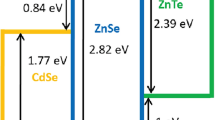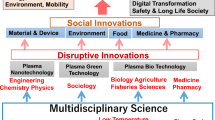Abstract
An innovative method, namely ultrafast plasma surface melting, is developed to fabricate solid films of silicon with very high rates (150 cm2/min). The method is composed of preparing a suspension of solid particles in a volatile solvent and spreading it on a refractory substrate such as Mo. After solvent evaporation, the resulting porous layer is exposed to the flame tale of inductively coupled RF plasma to sinter and melt the surface particles and to prepare a solid film of silicon. It is shown that by controlling the flow dynamics and heat transfer around the substrate, and managing the kinetic parameters (i.e., exposure time, substrate transport speed, and reaction kinetics) in the reactor, we can produce solid crystalline Si films with the potential applications in photovoltaic cells industry. The results indicate that the optimum formation conditions with a film thickness of 250-700 μm is when the exposure time in the plasma is in the range of 5-12.5 s for a 100 × 50 mm large layer. By combining the Fourier’s law of conduction with the experimental measurements, we obtained an effective heat diffusivity and developed a model to obtain heat diffusion in the porous layer exposed to the plasma. The model further predicts the minimum and maximum exposure time for the substrate in the plasma flame as a function of material properties, the porous layer thickness and of the imposed heat flux.









Similar content being viewed by others
Notes
Any refractory material stable in high temperature reductive environment can be used instead of Mo substrate.
Substrate speed, substrate to torch distance, plasma power, and relative velocity of plasma gas over the substrate are critical parameters that determine if we obtain sintered or melted silicon.
Note that the porosity of the dried layer before scanning by plasma flame is about 50%.
References
Gratzel, M, ‘Photovoltaic and photoelectrochemical conversion of solar energy’ Philosophical Transactions of the Royal Society London, Series A (Mathematical, Physical and Engineering Sciences), 15 April 2007, 365(1853), p 993–1005.
Goetzberger A., Hebling C., ‘Photovoltaic materials, past, present, future’ Solar Energy Materials & Solar Cells, 2000, 62, p 1–19.
Shah A.V., Schade H., Vanecek M., Meier J., Vallat-S.E., Wyrsch N., Kroll U., Droz C., Bailat J., ‘Thin-film silicon solar cell technology’ Progress in Photovoltaics: Research and Applications, 2004,12, p 113–142.
Nakano Y., Goya S., Watanabe T., Yamashita N., Yonekura Y., ‘High deposition rate of microcrystalline silicon solar cell by using VHF PECVD’ Thin Solid Films, 2006, 506–507, p 33–37.
Chae Y.K., Ohno H., Eguchi K., Yoshida T., ‘Ultrafast deposition of microcrystalline Si by thermal plasma chemical vapor deposition’ Journal of Applied Physics, 2001, 89(12), p 8311–8315.
Ferreira G.M., Ferlauto A.S., Chen C., Koval R.J., Pearce J.M., Ross C., Wronski C.R., Collins R.W., ‘Kinetics of silicon film growth and the deposition phase diagram’ Journal of Non-Crystalline Solids, 2004, 338–340, p 13–18.
Koval R., Koh J., Lu Z., Jiao L., Collins R.W., Wronski C.R., ‘Performance and stability of Si:H p–i–n solar cells with i layers prepared at the thickness-dependent amorphous-to-microcrystalline phase boundary’ Applied Physics Letters, 1999, 75(11), p 1553–1555.
Xu Y., Hu Z., Diao H., Cai Y., Zhang S., Zeng X., Hao H., Liao X., Fortunato E., Martins R. ‘Heterojunction solar cells with n-type nanocrystalline silicon emitters on p-type c-Si wafers’ Journal of Non-Crystalline Solids, 2006, 352, p 1972–1975.
Vidal E.,Taylor R. P., ‘Thermal Plasma Synthesis of BaFe12O19 (BaM) Films’ Plasma Chemistry and Plasma Processing, Dec. 2003, 23(4), p 609–626.
Sasaki T., Fujikake S., Tabuchi K., Yoshida T., Hama T., Sakai H., Ichikawa Y. (2000) ‘Structural study of p-type μc-Si layer for solar cell application’ Journal of Non-crystalline solids, 266–269, p 171–175.
B. Mostajeran Goortani, F. Gitzhofer, and E. Bouyer, Solid and Porous Film Formation from Particulate Materials by High Heat Flux Source, Patent (PCT/FR2007/001408), July 2007 (CEA, Grenoble, France and Sherbrooke University, Quebec, Canada)
M.I. Boulos, Purification of Metallurgical Grade Silicon, US Patent No. 4,379,777, April 12, 1983
Morvan, Amourous J., ‘Preparation of photovoltaic silicon by purification of metallurgical grade silicon with a reactive plasma process’ Plasma Chemistry and Plasma Processing, 1981,1(4), p 397–418.
Bourg F., Pellerin S., Morvan D., Amouroux J., Chapelle J., ‘Study of an argon–hydrogen RF inductive thermal plasma torch used for silicon deposition by optical emission spectroscopy’ Solar Energy Materials & Solar Cells, 2002,72, p 361–371.
Benmansour M., Francke E., Morvan D., Amouroux J., Ballutaud, D., ‘In flight treatment of metallurgical silicon powder by RF thermal plasma: elaboration of hydrogenated silicon deposit on a substrate’ Thin Solid Films, 2002, 403–404, p 112–115.
Tokmoldin S. Zh, Mukashev B.N., Abdullin, Kh.A., Gorelkinskii Yu.V., ‘Hydrogen interactions with interstitial- and vacancy-type defects in silicon’ Physica B: Condensed Matter, Dec, 1999, 273–274, p 204–207.
Jagannathan B., Anderson W.A., Coleman J., ‘Amorphous silicon p-type crystalline silicon heterojunction solar cells’ Solar Energy Materials & Solar Cells, 1997, 46, p 289–310.
R.H. Perry and D.W. Green, Perry’s Chemical Engineers’ Handbook, 7th ed., McGraw-Hill, 2007
H.S. Carslaw and J.C. Jaeger, Conduction of Heat in Solids, 2nd ed., Oxford University Press, 1986
Murphy A., ‘Transport coefficients of helium and argon-helium plasmas’ IEEE Transactions on Plasma Science, Oct. 1997, 25(5), p 809–814.
Aubreton J., Elchinger M. F., Rat V., Fauchais P., ‘Two-temperature transport coefficients in argon–helium thermal plasmas’ Journal of Physics D: Applied Physics, 2004, 37, p 31–41.
Acknowledgments
The authors highly appreciate the financial support of CEA (Grenoble, France) and NanoQuébec (Quebec, Canada). The support of the plasma laboratory technicians, Francis Barrette and of the mechanical technician Patrice Poulin through Plasma-Quebec grant is acknowledged. The collaboration of OPPUS group of the chemical engineering department for using their system for performing FluentTR simulations is well appreciated.
Author information
Authors and Affiliations
Corresponding author
Rights and permissions
About this article
Cite this article
Mostajeran Goortani, B., Gitzhofer, F., Bouyer, E. et al. Ultrafast Thermal Plasma Preparation of Solid Si Films with Potential Application in Photovoltaic Cells: A Parametric Study. J Therm Spray Tech 18, 50–57 (2009). https://doi.org/10.1007/s11666-008-9282-1
Received:
Revised:
Accepted:
Published:
Issue Date:
DOI: https://doi.org/10.1007/s11666-008-9282-1




